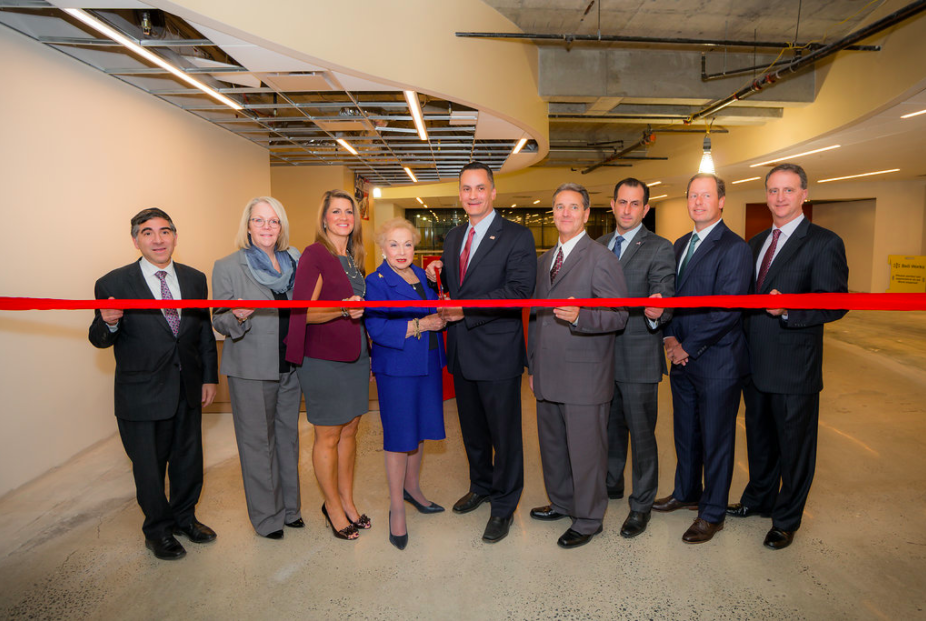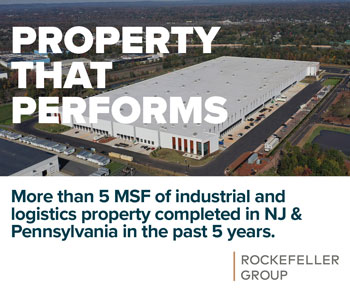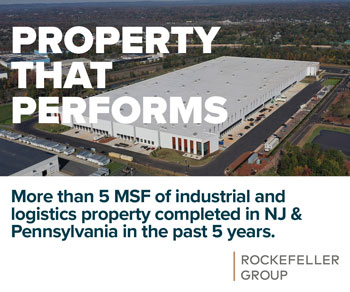By Joshua Burd
It wasn’t all that complicated.
That’s how Tim Touhey lightheartedly recalls his decision to join Investors Bank in spring 2013, following six years as CEO of the New Jersey Builders Association.

For one thing, the bank had set its sights on a region that Touhey knew well — central and southern New Jersey, along with Pennsylvania and Delaware — as part of its acquisition of Roma Financial Corp.
Add in the fact that he “thought the world of the executive team,” he said, referring to a well-known group that includes Kevin Cummings, Domenick Cama and Richard Spengler.
“For me, it just seemed like a natural fit,” Touhey said. “And they were phenomenal individuals in the marketplace, and as I got to know them I felt … their commitment to the growth of this market, so I jumped on it.”
Nearly five years later, the opportunity has equated to an impressive run for both Touhey and Short Hills-based Investors Bank. The institution’s expansion into central and southern New Jersey and neighboring states has been key to its growth during that time, with Touhey’s team having originated more than $3.4 billion in loans.
“We’ve got a very strong pipeline of business and the team has grown just based on what’s happened on the production side,” said Touhey, a senior vice president based in Investors’ Robbinsville office. “So I couldn’t be more pleased with the progression that we’ve had.”
He has helped steer that growth thanks in part to his deep ties to the region’s banking and commercial real estate sectors. Touhey, a former lead director of the Fannie Mae Northeast Community Business Center, has also served as the executive director of the New Jersey Housing and Mortgage Finance Authority, vice chair of the Council on Affordable Housing and chair of the State Planning Commission.
So it should come as no surprise that he has stayed involved in public policy even after leaving an advocacy group such as NJBA. He remains active with New Jersey Future, PlanSmart NJ and the influential builders association, among other organizations, in large part “because they dealt with land use issues and affordability issues, which I think are still very important.”
To talk about Investors’ growth in the region and some of the state’s key public policy issues, Real Estate NJ recently sat down with Touhey. Below are excerpts from our interview.
Real Estate NJ: How do you measure the progress that you’ve made here at Investors, relative to the original mission that you took on when you were hired?
Tim Touhey: I would say that, without tooting the horn too much here, I think we’ve been wildly successful. We’ve built out a marketplace and a branding in this market, where everybody knows that we’re probably the leading commercial real estate lender. But we’re part of a bigger team, so I get the good fortune of working with what I think is now one of the largest state banks in New Jersey. That’s what I love about it. We really have a team mentality here. It’s in the DNA of the bank and its culture. So it’s been an absolute team effort. … We’re branded now in this marketplace.
And when I say this marketplace, I mean New Jersey, Pennsylvania, and New York.
RENJ: Is there a particular asset class or specialty that that has been the greatest source of opportunity in this market?
TT: Multifamily probably drove 60 percent of our business and 40 was every other asset class. And that was really by design — we didn’t want to just be a multifamily lender.
Back up four years ago and I would say South Jersey was just at the beginning of its recovery. It wasn’t North Jersey yet. It wasn’t yet Central Jersey, as in New Brunswick. So Philadelphia became a very strong market for us initially and I think we were fortunate enough to get in at the beginning of that. And I think what happened was that once some local banks left that market, no other institutions were hitting that level of customer that we’re targeting, which is loans anywhere from $1 million to $10 million. So I felt like we could step into that void, which we did.
Fast-forward to now and I would say that for a variety of reasons, (such as) the tax incentives in Camden County, you are beginning to see a renaissance in South Jersey. And remember Atlantic City collapsed four years ago and they were trying to figure out what they were going to do — that had a massive impact on South Jersey. Fast-forward four years later and where are we? Well, Atlantic City now has some of our borrowers and they’re buying real estate. You’ve got some large developers down there. Revel just traded. So Atlantic City’s got some momentum around it to hopefully recover.
We’ve done big deals in South Jersey (such as a $42.5 million refinance for Cherry Hill Towers, a 434-unit apartment property in Cherry Hill, in 2014). And then as Philadelphia kind of matured and prices started moving up on the rental side, South Jersey became attractive for some folks. And then you had a renaissance on the commercial side with the relocation of some of the corporations and what’s happening to the city and around the city.
RENJ: Where do you feel is the opportunity going forward?
TT: I still think that there is a vacuum in the market of lenders that are looking at our footprint, which I think is our strength. And what I mean by that is the $2 million to $10 million marketplace. A lot of the lenders don’t like to spend time in that space. Our execution is very good, so when we compete with the other community banks down here, I think we have a bigger volume that we can deal with, our capital position is much different. So we’re not just a one-off to one borrower and we’re done. We kind of move through that, so I think that gives us our market advantage.
RENJ: One of your biggest personal assets is simply knowing so many people in commercial real estate and banking. Can that be a blessing and a curse for someone in your position, who must be getting pitched a lot of business?
TT: In my career, you always make sound decisions — never based on personalities, but on the fundamentals of whatever they’re bringing forward. Whether it’s a real estate deal or a policy discussion, you always have to look at the fundamentals. It’s great if you have a relationship and you know their history. That tells you a lot about a potential borrower, but really it’s the fundamentals of the real estate in the deal that you have to live by.

RENJ: Ralph Zucker of Somerset Development was someone you knew for many years going into last year, when Investors closed on a $70 million loan for the Bell Works project. How did that come together?
TT: I would say Ralph had phenomenal courage to look at Bell Works the way he did. I don’t think there’s anyone that wouldn’t have said to him, when he began to look at that real estate, ‘Are you kidding me?’ But there was something that Ralph, within his own belief or in his own experience in real estate, saw could happen at the end of the road.
And he had to kind of put that story together over time. And yes there were partners — he needed the city of Holmdel, then he needed the state of New Jersey. Then he needed Toll Bros., but he saw that vision. And so by the time we got involved in the deal, he had matured the real estate enough to make us look at it to say, ‘Yeah, this makes perfect sense.’
RENJ: With the organizations that you’re still especially active with, what are some of the biggest public policy issues that you’re focused on right now?
TT: I think there are three big issues that will be debated and discussed and are so critical to the survival of New Jersey long-term. One is obviously affordable housing and COAH and what happens as it relates to the stalling of the last 11 years of a clear affordable housing policy. It was neutered, and now it’s a priority for the judicial side, rather than on the administrative and COAH side, where COAH was the judge, the jury and strategic implementer of affordable housing. That lost its might under the Christie administration.
So we’ll see where this governor and legislators take the process. I think the courts have been pretty clear that affordable housing is a constitutional right in New Jersey. And so that discussion is going to be critical to predictability and growth in not just commercial real estate, but affordable housing in New Jersey.
Two (is) the passion around special assets — because of the land use restrictions in New Jersey, which I believe will not change and haven’t really changed, and the challenge of home rule in the state of New Jersey, which is again difficult as it relates to doing regional development planning. I think that special assets become a potential positive for municipalities. And I think it’s an important economic vehicle because we know how much is out there that could be redeveloped, so I think that’s going to be an important issue.
Three: The old state plan. What does that look like going forward? I think when you see the advantage of competitive markets that I’ve been able to see — since I’m not just doing lending in New Jersey — when you look at a state like Maryland that has identified clear approved land development opportunities that you know going in, New Jersey is still at a disadvantage in that place. So I’ve always been and will continue to be a strong proponent that we need a state plan with teeth that has predictability, that allows for development to take place where it should take place and give the development community that predictability. (Otherwise) we will continue to have a market disadvantage. … I think the Amazon RFP process demonstrated that cities that were prepared like New Brunswick, Newark and Trenton, who had a strategy put together, could compete against other neighboring markets. And every town in New Jersey is going to need that, so that’s what I thought the state would do.
A signature deal
Well before Investors Bank provided a loan for the landmark Bell Works project last year, Tim Touhey had known all about Somerset Development’s bold adaptive reuse project in Holmdel.
Admittedly, Touhey’s opinion had to change over time.
“We had a great borrower, a great sponsor in Ralph Zucker,” Touhey said. “(He) had the vision to look at a massive piece of real estate in New Jersey and say, ‘I think I can make this work.’ I think when I first met him on this deal, I said, ‘Ralph, you’re crazy.’
“He proved me wrong.”
Investors’ $70 million loan for Somerset was among its largest and most high-profile commercial real estate deals last year. The institution served as the lead bank in structuring the loan package for the project, which was brokered by Meridian Capital Group and also included financing from OceanFirst Bank, as part of Somerset’s effort to redevelop the 2 million-square-foot former Bell Labs complex as a vibrant mixed-use environment.
Touhey, who had known Zucker for years prior to joining Investors in 2013, said “it was such a phenomenal deal for us and, more importantly, for the state.”
And he credited Zucker for his perseverance, in that it took Bell Works several years to get it to a place where the developer was “ready to position it to the marketplace.”
Zucker did so by finding patient partners, then by leveraging the state’s lucrative incentive programs to attract anchor office tenants such as iCIMS. Touhey also pointed to the decision by Toll Bros. to buy the land around the complex to create a for-sale housing market there.
“All of those variables then became an attractive deal,” Touhey said. “And Bell Works doesn’t just serve Holmdel. It serves a region — and I think Bell Works is an example of what may and could happen in New Jersey in the next 10 years, with a variety of stranded assets that have had this scope and nature and have needed this kind of innovation to create it.
“So he didn’t just create an office space. He created a community.”
For an institution that positions itself as a community bank, that’s an appealing proposition.
“So it was really that kind of partnership that got us all comfortable to say, ‘Let’s make this happen,’ ” Touhey said. “Now it’s wildly successful. … It’s an important asset, and I think he has demonstrated — which is even more important — that these kinds of assets can be recreated.
And we as lenders welcome the opportunity.”











